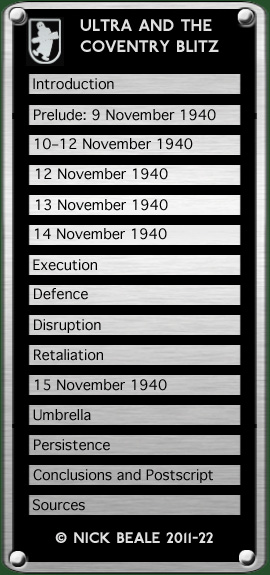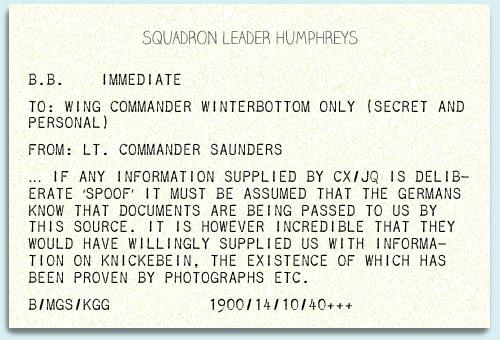
|
||
|
I came to work on this partly as a follow-on to the piece here about KGr. 100’s early days in France and also because I wanted to see what Ultra actually said and when about the impending attack on Coventry. I get frustrated by authors who say things like “Ultra would have told the Allies …” without apparently looking at the relevant signals, so I thought I'd check. The first thing to say is that Dr. R.V. Jones’s Most Secret War has proved to be highly reliable; there is nothing in the files I have read that contradicts his account in any significant detail. Ken Wakefield’s Pfadfinder is also very good on the Coventry Blitz (and a great deal else). What I hope to have contributed is a sense of the gaps in the information available to the RAF and also to show just how much was done in the space of a couple of days to try and disrupt German plans.
At 19.45 hours on 9 November 1940, an He 111 crashed on number 26 Johnson Road, Bromley in Kent—or rather most of it did: one wing, torn off by a direct hit from AA fire, fell some distance away, in Chislehurst. This aircraft, W.Nr. 3335 V4+IK of 2./KG 1, had been on its way from Montdidier to London and 16 x 50 kg bombs were found in the wreckage. Mrs Alice Monday was killed and six other residents injured; Police Sgt. David Grigg and Lt. Charles Lea of the Royal Engineers were awarded the George Cross for their courage in helping the injured and dealing with the bombs. Only one member of the crew survived, the pilot Ltn. Max Probst; previously unimpressed by the British guns, he had been flying at 4–5000 m. when the shell struck. He bailed out through his cabin roof hatch as the Heinkel turned on to its back; another crew member jumped but his parachute had not opened completely and his body was found on the roof of number 14. Somewhere between 07.35 GMT on Sunday 10 November and 05.00 on Monday the 11th a German signal was deciphered.
In it the Signals Officer of Fliegerkorps I issued KGr. 100 with wireless codes and frequencies for “Moonlight Sonata.” These instructions had been sent at 14.00 hours GMT on Saturday the 9th and a day’s interval before decryption seems to have been normal at this period. The signal itself was quite lengthy and gave neither a date nor a target but It did set out the call-sign for KGr. 100’s aircraft: F4G followed by a letter (Gruppenkommandeur Aschenbrenner’s machine would be F4GA). An important point for the RAF was that KGr. 100 was to issue a tuning signal under call-sign D3R at 13.00 hours GMT on the day of the operation. Luftflotte 3 would repeat the signal 15 minutes later. Detection of this signal would thus serve as a warning of imminent attack. There was also a list of number-codes to be transmitted at various stages of the operation, for example: 15–18 denoted target areas 1, 2, 3 and 4 respectively; 62 meant “intersection of beam is over the target”; and 9 meant “Korn.” Bletchley Park did not suggest any interpretation of this word (the German for “grain”) but did propose—probably to no one’s great surprise—that “Moonlight Sonata” was the name of a specific operation. Some of the number codes suggested that KGr. 100 would act both as pathfinders and as “masters of ceremonies”, updating following units on the weather at the coast and target and on the accuracy of the beams themselves. There were also provisions for switching the beams to an alternative target if the weather did prove bad. Between 05.00 GMT on Monday and 03.35 on Tuesday, a new message was broken in which an officer at Vannes, KGr. 100’s base, told the “river group” of navigational beam stations (so-called for their code names: WESER, SPREE, ELBE, RHEIN and ISAR) to prepare for new targets 51, 52 and 53. From the bearings given and knowledge of the transmitters’ locations, the Air Ministry was able to identify these targets as Wolverhampton, Birmingham and Coventry. These attributions were not included as comments in the day’s typed report from Bletchley, rather they are faintly pencilled-in on copy no. 11, presumably by its recipient, Commander M.G. Saunders of Hut 3. continued on next page …
|
||||||




